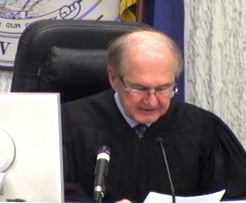Listman vs OMC trial 18 November Session 1a – Judge’s Instructions to the Jury
This post is part of our coverage of the Listman v. OMC propeller injury trial
Robin Listman vs. Outboard Marine Corporation
Second Judicial District Court of the State of Nevada, County of Washoe
18 November 2011 Session One
Our coverage was obtained via a video feed supplied by Courtroom View Network (CVN). The images are also courtesy of CVN.
This session focused on the Judge’s Instructions to the Jury Prior to Closing Arguments
We heard from Judge Polaha
Judge Polaha Instructs the Jury
Judge Polaha read 36 pages of instructions to the Jury. Many of those pages only had a short paragraph on them. Copies were supplied to the Jury so they could follow along.Several of the points are listed below. These are not written verbatim. They come from our hastily written notes and a few slides we captured.
- Not to single out certain pieces of them, and that the order they were read in had no significance.
- The charts and summaries were only as good as the underlying evidence that supports them.
- Legislative or administrative regulatory standards are evidence of a product’s safety. However evidence as to whether or not OMC confirmed to a standard of the industry or a government standard in the design of a product is not controlling of the question as to whether or not the product is defective in its design.
- A product is unreasonably dangerous if it failed to perform in the manner reasonably to be expected in light of its nature and intended function and was more dangerous than would be contemplated by the ordinary user having the ordinary knowledge available in the community.
- For a claim of design defect including that of alternative design, any proposed change in design must be commercially feasibly. The technology must be available, the cost must not be prohibitive, the product remains efficient and must be within the state of the art at the time the product was places in the stream of commerce.
- Statements, arguments, and opinions by counsel are not evidence in the case. However, if attorney’s stipulate as to the evidence of a fact, you must accept the stipulation as evidence and regard that fact as proved.
- You must not speculate to be true any insinuations suggested by questions asked a witness.
- You must disregard any evidence to which an objection was sustained by the court and evidence ordered stricken by the court.
- Anything you have seen or heard outside the courtroom is not evidence and must be disregarded.
- A legal cause of injury, damage, loss, or harm is a cause which is a substantial factor in bringing about the injury, damage, loss, or harm.
- As permitted by law, the parties served upon each other a written request for the admission of the truth of certain matters of fact. You will regard as being conclusively proved all such matters which were expressly admitted by the parties or which the parties failed to deny.
- Negligence on the part of the plaintiff which cooperating to some degree with the conduct of another helps in legally causing the plaintiff’s injury is not a defense to a claim based on strict products liability and does not operate to reduce the amount of damages, if any, to which plaintiff would otherwise be entitled.
- Whether or not either party was insured is immaterial.
The Judge explained that in order to establishing strict liability for a defective product the plaintiff must prove the following elements by a preponderance of evidence:
- That OMC was the manufacturer of the product
- That the product possessed a defect in its design
- That defect in design existed when it left OMC’s possession
- That product was used in a manner reasonably foreseeable by OMC AND
- That defect in design was a legal cause of the damage or injury to plaintiff
The Judge explained “Assumed Risk”:
The Defendant contends that the Plaintiff assumed the risk of the harm that she suffered. To establish that the Plaintiff assumed this risk, the Defendant must show by a preponderance of evidence that :
- The Plaintiff actually knew and appreciated the particular risk or danger created by the defect.
- The Plaintiff voluntarily encountered this risk while realizing the danger AND
- The Plaintiff’s decision to voluntarily encounter the unknown risk was unreasonable.
A person who thus assumes the risk is not entitled to recover for damages which resulted from the danger to which he or she exposed himself or herself.
National statistics were furnished indicating women of Robin Listman’s age have a life expectancy of 40.76 years. The judge noted that some people live longer and some do not live as long.

